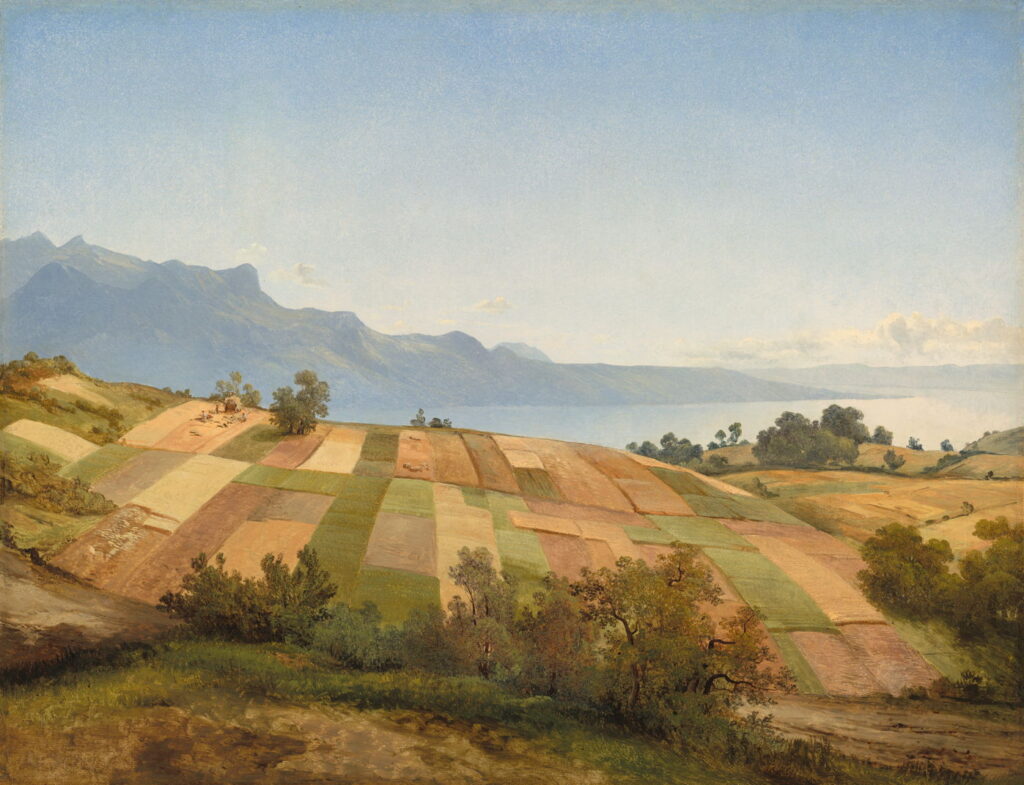A to Z of Landscapes: Aerial perspective

In this the first of a new series about landscape painting, I start with the letter A, which must be for aerial perspective.
Until the recent advent of digital manipulation of images, only painters could control all aspects of their two-dimensional representations of three-dimensional views. By enhancing visual cues for depth, a painting can make a landscape look deeper; by reducing those cues it can look flat. Among the most manipulable cues to depth in many landscape paintings are those of aerial perspective: the way that distant hills fade in contrast, detail and colour, and how their hue shifts towards cooler colours. As these don’t normally come into effect for objects within a kilometre of the painter or viewer, aerial perspective is the concern of only the landscape painter.
Aerial perspective is composed of several related optical effects, including the following features with increasing distance, prominent when more than a kilometre from the observer:
a reduction in the difference in lightness between an object and its background,
resulting in a reduction in the range of lightness values, or contrast,
resultant loss of detail in objects,
reduction in chroma generally,
a shift in hue, normally towards blue (‘cooler’ colours).
A mountain view near Alpe d’Huez, French Alps, showing aerial perspective effects. The colour bar at the right shows the shift in hue from foreground back. © EHN & DIJ Oakley.
These are shown clearly in the coloured and monochrome versions of this photograph, taken in the French Alps during fine but slightly hazy weather.
The same image, desaturated to monochrome, to show the different lightness and contrast with distance. © EHN & DIJ Oakley.
Prior to the Renaissance, landscapes were more symbolic, and no attempt was made to depict them realistically. While painters of the Northern Renaissance, with their emphasis on optical realism, were quick to grasp the essentials of aerial perspective, its adoption was more gradual in the Southern Renaissance.
Antonello da Messina (c 1430–1479), Saint Jerome in his Study (c 1475), oil on lime wood, 45.7 x 36.2 cm, The National Gallery, London. Wikimedia Commons.
Antonello, who was largely responsible for the introduction of oil painting to the Southern Renaissance, shows his approach in the tiny landscape vignettes in his Saint Jerome in his Study from about 1475. The detail of one of those views is shown below, and demonstrates that the artist already understood the basics, although there’s little sign of any shift in hue.
Antonello da Messina (c 1430–1479), Saint Jerome in his Study (detail) (c 1475), oil on lime wood, 45.7 x 36.2 cm, The National Gallery, London. Wikimedia Commons.
Leonardo da Vinci (1452–1519), Madonna of the Carnation (c 1477-78), oil on poplar, 62 x 47.5 cm, Alte Pinakothek, Maxvorstadt, Germany. Image by Yelkrokoyade, via Wikimedia Commons.
Madonna of the Carnation from about 1477-78 is perhaps the most complex and ambitious of Leonardo da Vinci’s early works to have survived. In addition to its conventional figures, there’s a detailed landscape beyond the symmetry of the windows, with marked aerial perspective.
Giorgione (1477–1510), Virgin and Child with Saint Nicasius and Saint Francis of Assisi (‘Castelfranco Altarpiece’) (c 1500), oil on panel, 200 x 152 cm, Duomo di Santa Maria Assunta e San Liberale, Castelfranco, Veneto, Italy. Wikimedia Commons.
Giorgione’s Virgin and Child with Saint Nicasius and Saint Francis of Assisi (the ‘Castelfranco Altarpiece’) from about 1500 combines a fine depiction of the Virgin and infant Christ with two wonderful saintly figures, and an innovative naturalist landscape. The buildings at the upper left are meticulously painted, and there is excellent aerial perspective at the upper right.
Joachim Patinir (c 1480-1524), Crossing the River Styx (1520-4), oil on panel, 64 x 103 cm, Museo Nacional del Prado, Madrid. Wikimedia Commons.
A few years later, Joachim Patinir realised the power of the World View in his Crossing the River Styx (1520-4). The spectator is elevated above the surface and looks on and down over a richly detailed landscape that stretches to the far horizon. Although he has painted a crisp and clear horizon to the sea, he uses marked aerial perspective for the land on the left, making it recede into distant haze, to give the impression of great depth of view.
Like other conventions of painting, aerial perspective came under question in the nineteenth century.
Alexandre Calame (1810–1864), Swiss Landscape (c 1830), oil on paper mounted on canvas, 40 × 52 cm, National Gallery of Art, Washington, DC. Wikimedia Commons.
Alexandre Calame’s superb Swiss Landscape was painted in about 1830, when the artist was about twenty. It shows the shore of one of the country’s large lakes, probably Lake Geneva, and is a textbook example of aerial perspective.
Eugène Burnand (1850–1921), Bull in the Alps (1884), oil, dimensions and location not known. Wikimedia Commons.
Eugène Burnand’s magnificent painting of Bull in the Alps from 1884 is fascinating for his use of both optical effects and extreme aerial perspective. Not only are there marked contrasts between the foreground and background in terms of chroma, hue and lightness, but Burnand has used defocussing in a photographic manner. The crisp edges of the bull stand proud of the softer edges and forms in the mountains behind.
Of the Impressionists, it’s often claimed that it was Paul Cézanne who flouted previous conventions on perspective the most, as a mark of his ‘primitivism’ and rebellion against the academy.
Paul Cézanne (1839-1906), La Montagne Sainte-Victoire au grand pin (1886-7) Rewald no. 598. Oil on canvas, 59.7 x 72.5 cm, Phillips Collection, Washington DC (WikiArt). Framed by the repoussoir pines, the distant mountain shows marked aerial perspective.
The evidence for this isn’t consistent with the claims. In many of Cézanne’s landscapes throughout his career, he followed the conventions of perspective, including the use of aerial perspective, as shown in this view of Montagne Sainte-Victoire, where the distant mountain is different in warmth and/or hue to the middle- and foreground. Above is an example from 1886-87, and below a version painted by his close friend Auguste Renoir in 1888-89.
Pierre-Auguste Renoir (1841–1919), Montagne Sainte-Victoire (c 1888-89), oil on canvas, 53 x 64.1 cm, Yale University Art Gallery, New Haven, CT. Wikimedia Commons.
Late in his career, though, Cézanne did paint some views in which he abandons aerial perspective completely.
Paul Cézanne, Le Lac d’Annecy (Lake Annecy) (1896) (R805), oil on canvas, 65 x 81 cm, The Courtauld Gallery, London (Samuel Courtauld Trust) (P.1932.SC.60). Wikimedia Commons.
His Le Lac d’Annecy from 1896 is generally taken as the inception of his most radical style and approach to painting. Compared to modern satellite images, the distance between the artist’s point of view and the Château de Duingt on the opposite side of the lake is 800 metres (just under half a mile), but it appears to be far closer than that, at least in part because he uses not one of the effects of aerial perspective.
Vincent van Gogh (1853–1890), Wheat Field with Cypresses (1889), oil on canvas, 73.2 × 93.4 cm, Metropolitan Museum of Art, New York, NY. Wikimedia Commons.
By comparison, Vincent van Gogh was far more conventional in his use of aerial perspective. This early sketch of Wheat Field with Cypresses made in the summer of 1889 follows each of the five principles. Unlike some Post-Impressionists, van Gogh appears to have remained closer to the plein air tradition, and this painting may even have been completed in a single sitting in front of the motif.



